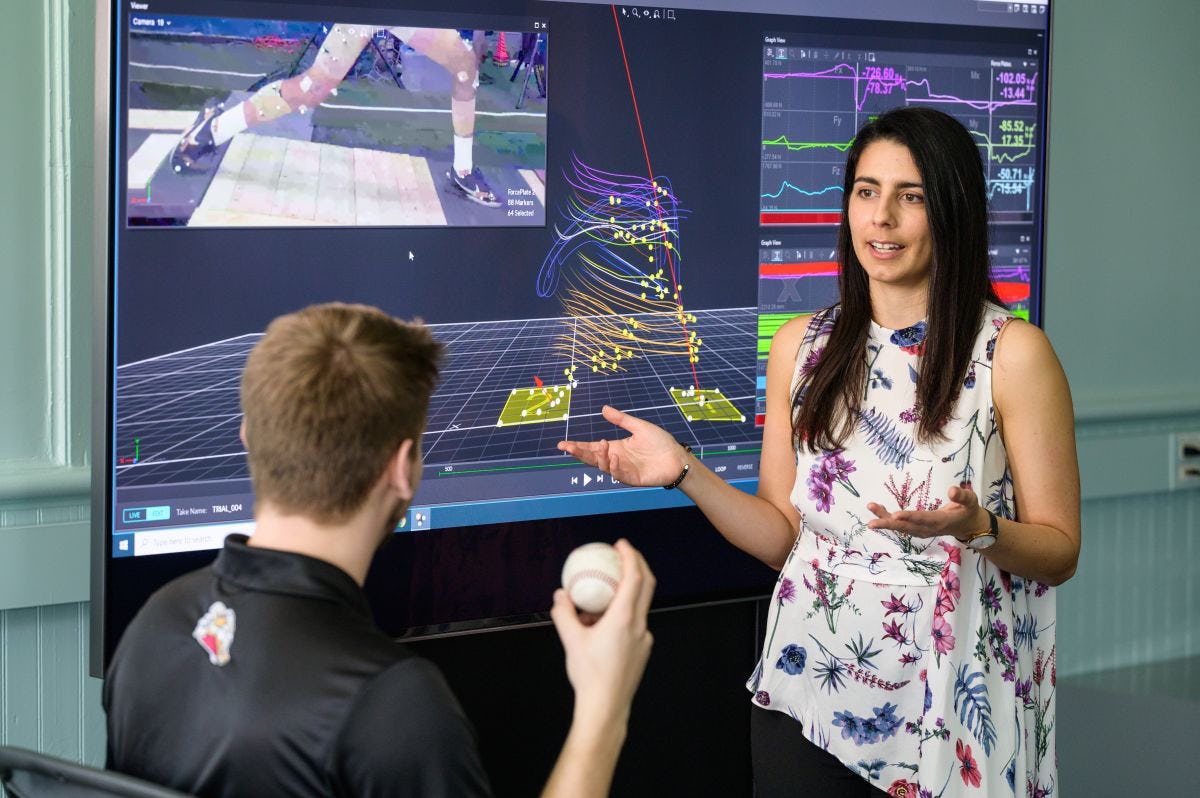Zaferiou Lab Continues Ground-Up Approach to Studying the Mechanics of Baseball Pitchers
For many, the dawning of spring is synonymous with the arrival of another baseball season. A time of year in which optimism abounds. However, for those who may not follow baseball closely, there is an epidemic of sorts currently plaguing the game: the increased injury rate of young pitchers.
In December 2024, Major League Baseball released the results of a yearlong study on this problem. A key finding showed approximately half of Tommy John surgical procedures – the most common surgery to repair a player’s ulnar collateral ligament (UCL) in their elbow – are performed on youth and high school pitchers.
Antonia Zaferiou, assistant professor in Stevens’ Department of Biomedical Engineering, and her team have spent years examining the mechanics of pitchers. Zaferiou, who joined Stevens in 2019, leverages a "ground-up" approach to pitching mechanics. One of her team’s previous studies analyzed impulse measurements – the summation of forces or torques applied onto the athlete’s body from the interactions of each leg over duration of time in the pitching motion – in professional (minor-league-level) pitchers.
Her newest project, continuing collaboration with Rush University in Chicago, also studies impulse from pitchers’ legs during the pitch. But this time, the data were focused on high school pitchers throwing two specific pitches: fastballs and changeups (pitches that are thrown with the same motion as fastballs but usually apply a third finger on the ball to increase drag and slow the ball down to deceive the batter).
Picking up from previous projects
Led by Zaferiou, Stevens graduate research assistants Samantha Gajda and Jun Liu recently published a paper on their newest research in the March 2025 issue of the Journal of Biomechanics. The paper, titled "Linear and angular impulse generated by high school pitchers during fastballs and changeups," reported findings from the project’s three key objectives: what are the roles of each leg in generating momentum, do these roles change between fastballs and changeups, and is the total momentum generated related to ball speed?
"The fact that there are so many different ways pitchers can solve the mechanical problem to effectively pitch with their bodies is truly fascinating," said Zaferiou. "Stevens students have been leading efforts to answer exciting research questions about how momentum is controlled during baseball pitching, and how that relates to performance outcomes."
To perform the study, 23 high school pitchers volunteered to throw, with a handheld radar gun measuring ball speed from behind the pitcher’s shoulder. Twenty tripod-mounted optical motion-capture cameras surrounded the pitchers’ mound and two force plates were placed in the mound, one under the flat top of the mound from which the pitcher pushes off with their back leg and one on the slope of the mound based on where the pitcher’s stride lands with their front foot. The force plates are like "fancy bathroom scales" that measure ground reaction forces (GRFs) both vertically and side to side (horizontally). These force measurements allow computation of linear and angular impulses generated by each leg, which tells us how the body’s momentum is generated.
This research differs from most previous studies because Zaferiou’s team focuses on impulse (the summation of the forces or torques through time), rather than peaks that occur at one instant in time.
"This is important because if we only looked at peak forces, we would have aligned with prior work that suggested that the front leg was more responsible for body rotations," said Zaferiou. "Instead, we focus on the cumulative effect of how the forces experienced through time generate momentum."
No change in total impulses between the changeup and fastball
The results of the study matched the group’s hypothesis that the back leg would dictate much more impulse both linearly and rotationally, as it did in Zaferiou’s previous project. However, the hypothesis that impulse would correlate with ball speed was not supported at a group level, with some between-pitch-type differences in impulses exhibited by individual pitchers.
Group-level results did not show that net linear or angular impulses were significantly greater during fastballs versus changeups, despite significantly greater ball speeds during the fastballs.
"Though we expected to see some level of associations between ball speeds and whole-body momenta, it is encouraging that these high school players were able to achieve the differences in ball speed intended without drastic observable changes in their momenta at the whole-body level. This is encouraging because observable changes could reveal their next pitch, with adverse performance outcomes," said Zaferiou. "Additionally, we were excited to highlight that there were many valid solutions to this mechanical challenge of pitching, so each person can find the best way for their own body to throw. The big question remains if each pitcher is finding an ideal for themselves that balances not only the desire to throw faster while maintaining accuracy, but to also remain safe from injury."
As far as the injury epidemic is concerned, Zaferiou attended a March event co-hosted by the Society for American Baseball Research (SABR) and American Society of Baseball Biomechanics, for which Zaferiou is a board of directors member. MLB’s injury report was the focal point of the cross-disciplinary discussion.
"The best part of the discussion was the urgent prompt to find ways to monitor player capacity and fatigue to contextualize loading measures," said Zaferiou. "This reiterates our observation of person-specific mechanics. By better understanding the fundamentals of the movement mechanics in our work at a person-specific level, we will help quantify motor control priorities in light of person-specific capacities and fatigue contexts."
In the future, Zaferiou is interested in studying the transfer of momenta through the joints and how that could explain the relationship between joint biomechanics and ball-speed outcomes.


